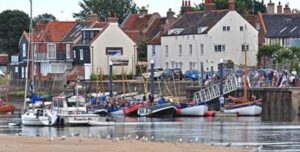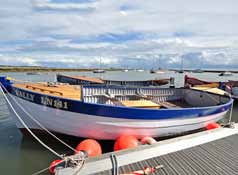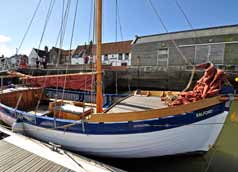Wooden fishing boat enthusiasts had a treat recently when 17 traditional North Norfolk crabbers and whelkers mustered at Tugboat Yard, Wells, on the first full day of Wells-next-the-Sea Carnival week
A majority of the North Norfolk crabbers and whelkers had been built by one or other of two noted Norfolk builders of the mid-20th century, Billy May of Potter Heigham and the Emery family of Sheringham, reports John Worrall.
At some time subsequently, every traditional boat has been worked on by one or other of the Hewitt brothers at Stiffkey. The Hewitts’ yard is also the base for the charity Rescue Wooden Boats: rescuewoodenboats.com (Fishing News, 28 January, 2016), which does what it says on the tin, and was set up in 2011 by David and George Hewitt together with two leisure crab-boat owners, psychologist Wendy Pritchard and judge Graeme Peart.
The fleet of traditional crabbers and whelkers, with their colourful paint jobs, certainly looked the part when the sun was out, and they attracted a lot of interest during the day, drawing people along to the eastern end of the harbour and featuring in no end of selfies.

The crabbers and
whelkers were
on display at
Tugboat Yard at the eastern end of the harbour.
And then at 6pm, they mustered and cruised out in line along Wells quay, carrying owners and families and friends past the granary, long since converted to flats, past all the holiday-makers eating fish and chips and ice-creams, and dangling crab nets and lines, past the Dutch North Sea clipper Albatros, the last sail trader to work to the UK – to Macduff as well as to Wells – and these days moored at the quay as a pub, Dutch pancake house and music venue.
And then, as the fleet turned seawards into the winding, milelong channel, punching into the flood past the new pontoons where seagoing motor-cruisers were rafted three deep, their occupants turning languidly to watch the heritage go by, a squall blew in, stretching pennants and scattering everyone ashore to cover. But the fleet sailed on, fully used to that sort of thing – or at least the boats themselves were.
The North Norfolk heritage fleet
On this particular Saturday, in bright sunshine interspersed with blustery showers – the first rain for a couple of months – David Hewitt conducted Fishing News along the pontoon for an inspection of the fleet
The Whelkers

“Knot was built in 1938 at Sheringham by the Emery family. She worked out of Wells on whelks from 1942, and spent most of her working life here until the mid-1970s. She was the last wooden whelker to go whelking. Knot stopped in 2001, when she was at Blakeney. Andy MacCullum (Wells fisherman, for the past decade working Two Brothers – see Fishing News, 14 November, 2008) had her then; she helped make him what he is today.”

“Sally was also built by the Emerys, in 1939, but was brought to Wells by train and was put inside one of the whelk houses for the duration of the war, before starting whelking in 1945. She was here all her whelking life and was one of the best-known of all the Wells boats, working here until 1973 or 1974. Tony Jordan, a very well-known Wells fisherman, used her. She’s a beautiful old boat. She’s just undergone a complete refit at our place, and will be here in Wells from now on.”

“Harvester was the last wooden whelker that was built – in 1951 by Emery’s of Sheringham, for Sid ‘Custard’ Cooper; she worked from Wells from 1951 to 1971. She didn’t work properly after that, spending a few years at Blakeney and Thornham doing angling parties. But she is remarkably well-built, larch on oak, but very heavily timbered. And she was the first working boat in North Norfolk to have a hydraulic pot hauler. All the Wells boats had an Austin 7 engine with a half back axle and a bollard on the top, but she had a hydraulic capstan, fitted new.”

“Salford was built by Worfolk’s at Lynn (for the Worfolk boatbuilding dynasty, see ‘Baden Powell’, Fishing News, 2 February, 2017). They weren’t really whelker builders, let’s face it. They were smack builders and they never got whelkers quite right. They built them a lot bigger, and they were weak for their size, and always suffered for it. She was built for Brancaster, to cart mussels as well as going whelking, and that was a compromise – a flat build. You compromise a sea boat with a flat build.”
The crabbers

“Auk is the newest crab boat, three years old. We (David and his apprentice, Tom Gathercole) built her. She’s just a pleasure boat, but we brought her along to show that you can still have a traditional North Norfolk crabber if you want one.” (Auk is the first wooden crab boat built in Norfolk for 25 years.)

“My Girls, built by Billy May in 1964. She spent all her working life at Sheringham with the Little family – Richard Little and Roy Little.”

“Amanda Lynne has just completed a major refit. She was built by Billy May in the mid-1970s, and spent all her working life at Cromer with Dennis Gaff, who was quite an important man in crab-boat history, because he had the first Billy May crab boat ever built. And Michael Edward, another Billy May boat, built in 1978 for the Davies family in Cromer.”

“Our Boys, built by Emery’s of Sheringham in 1950, for Henry ‘Joyful’ West. Our Boys spent all her working life at Sheringham. And Welcome Messenger, built by Billy May in 1963 for Bennett Middleton at Sheringham. She also spent all her working life at Sheringham. And just beyond, beside her, though you can’t really see, is Calico Jack, a crab boat built for Negging at Eccles. She spent her life at Cart Gap. But she was a pulling boat that we converted into a motorboat.”

“Early Rose, built by Billy May in 1969. She was the first crab boat to be built with a useable diesel. They put a Lister in, which was no good at all because it wasn’t quick enough. So they put in a Perkins 4107.”

“Joan Elizabeth, built by Billy May in 1969. She spent all her working life at Sheringham – Richard Little had her. She was one of the first of the modern shape with the splayed-out stern.”

“Billywich, built by Billy May in 1971. She was one of the biggest crab boats, one of three that were 23ft long. Billy May built all of them. Crab boats didn’t get any bigger than that. She worked for a while out of Saltfleet Haven in Lincolnshire with the Walkers (who recently built a catamaran – see Fishing News, 8 March, 2018). She came back here in 1987. Then we converted her back to a proper beach boat, and she spent her working life at Overstrand.”

“Valerie Theresa is the very last working wooden crab boat ever built, in 1989, and we built her, but by then, working wooden crab boats were more or less finished.” (Most beach boats are now GRP.) “John Balls had her built. He’s now crabbing out of Clovelly.”

“Miss Britain, built by the Emerys in 1965, for Jimmy ‘Paris’ West. She was one of the last crab boats built at Sheringham, but she spent most of her working life at Overstrand and Trimingham.”

“Jonathan James, again built by Billy May in 1968, for Roger Seago. She spent all her working life at East Runton, fishing until the mid-1990s.”








